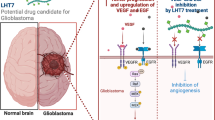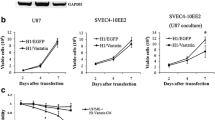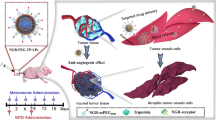Abstract
We have previously shown that laminin-8, a vascular basement membrane component, was overexpressed in human glioblastomas multiforme and their adjacent tissues compared to normal brain. Increased laminin-8 correlated with shorter glioblastoma recurrence time and poor patient survival making it a potential marker for glioblastoma diagnostics and prediction of disease outcome. However, laminin-8 therapeutic potential was unknown because the technology of blocking the expression of multi-chain complex proteins was not yet developed. To inhibit the expression of laminin-8 constituents in glioblastoma in vitro and in vivo, we used Polycefin, a bioconjugate drug delivery system based on slime-mold Physarum polycephalum-derived poly(malic acid). It carries an attached transferrin receptor antibody to target tumor cells and to deliver two conjugated morpholino antisense oligonucleotides against laminin-8 α4 and β1 chains. Polycefin efficiently inhibited the expression of both laminin-8 chains by cultured glioblastoma cells. Intracranial Polycefin treatment of human U87MG glioblastoma-bearing nude rats reduced incorporation of both tumor-derived laminin-8 chains into vascular basement membranes. Polycefin was thus able to simultaneously inhibit the expression of two different chains of a complex protein. The treatment also significantly reduced tumor microvessel density (p < 0.001) and area (p < 0.001) and increased animal survival (p < 0.0004). These data suggest that laminin-8 may be important for glioblastoma angiogenesis. Polycefin, a versatile nanoscale drug delivery system, was suitable for in vivo delivery of two antisense oligonucleotides to brain tumor cells causing a reduction of glioblastoma angiogenesis and an increase of animal survival. This system may hold promise for future clinical applications.





Similar content being viewed by others
References
Hallmann R, Horn N, Selg M et al (2005) Expression and function of laminins in the embryonic and mature vasculature. Physiol Rev 85:979–1000
Fujiwara H, Gu J, Sekiguchi K (2004) Rac regulates integrin-mediated endothelial cell adhesion and migration on laminin-8. Exp Cell Res 292:67–77
Ljubimova JY, Lakhter AJ, Loksh A et al (2001) Overexpression of α4 chain-containing laminins in human glial tumors identified by gene microarray analysis. Cancer Res 61:5601–5610
Ljubimova JY, Fugita M, Khazenzon NM et al (2004) Association between laminin-8 and glial tumor grade, recurrence, and patient survival. Cancer 101:604–612
Fujita M, Khazenzon NM, Bose S et al (2005) Overexpression of β1 chain-containing laminins in capillary basement membranes of human breast cancer and its metastases. Breast Cancer Res 7:411–421
Khazenzon NM, Ljubimov AV, Lakhter AJ et al (2003) Antisense inhibition of laminin-8 expression reduces invasion of human gliomas in vitro. Mol Cancer Ther 2:985–994
Torchilin VP, Lukyanov AN (2003) Peptide and protein drug delivery to and into tumors: challenges and solutions. Drug Discov Today 8:259–266
Peterson CM, Shiah J, Sun Y et al (2003) HPMA copolymer delivery of chemotherapy and photodynamic therapy in ovarian cancer. Adv Exp Med Biol 519:101–123
Maeda H, Fang J, Inutsuka T et al (2003) Vascular permeability enhancement in solid tumor: various factors, mechanisms involved and its implications. Int Immunopharmacol 3:319–328
Satchi-Fainaro R, Puder M, Davies JW et al (2004) Targeting angiogenesis with a conjugate of HPMA copolymer and TNP-470. Nat Med 10:255–261
Lee BS, Vert M, Holler E (2002) Water-soluble aliphatic polyesters: poly(malic acid)s. In: Doi Y, Steinbüchel A, (ed) Biopolymers, vol 3a. Wiley-VCH, New York, pp 75–103
Gasslmaier B, Holler E (1997). Specificity and direction of depolymerization of β-poly(L-malate) catalysed by polymalatase from Physarum polycephalum. Fluorescence labeling at the carboxy-terminus of β-poly(L-malate). Eur J Biochem 250:308–314
Domurado D, Fournié P, Braud C et al (2003) In vivo fates of degradable poly(β-malic acid), and of its precursor, malic acid. J Bioact Compat Pol 18:23–32
Lee BS, Fujita M, Khazenzon NM et al (2006) Polycefin, a new prototype of a multifunctional nanoconjugate based on poly(β-L-malic acid) for drug delivery. Bioconjug Chem 17:317–326
Zhang Y, Zhang YF, Bryant J et al (2004) Intravenous RNA interference gene therapy targeting the human epidermal growth factor receptor prolongs survival in intracranial brain cancer. Clin Cancer Res 10:3667–3677
Troncoso P, Ortiz AM, Dominguez J et al (2005) Use of FTY 720 and ICAM-1 antisense oligonucleotides for attenuating chronic renal damage secondary to ischemia-reperfusion injury. Transplant Proc 37:4284–4288
Kutryk MJ, Foley DP, van den Brand M et al (2002) Local intracoronary administration of antisense oligonucleotide against c-myc for the prevention of in-stent restenosis: results of the randomized investigation by the Thoraxcenter of antisense DNA using local delivery and IVUS after coronary stenting (ITALICS) trial. J Am Coll Cardiol 39:281–287
Lambert DL, Malik N, Shepherd L et al (2001) Localization of c-Myb and induction of apoptosis by antisense oligonucleotide c-Myb after angioplasty of porcine coronary arteries. Arterioscler Thromb Vasc Biol 21:1727–1732
Yoshizumi T, Yonemitsu Y, Ikeda Y et al (2006) Tumor necrosis factor-a antisense transfer remarkably improves hepatic graft viability. Liver Int 26:451–456
Countryman RA, Kaban NL, Colombo PJ (2005) Hippocampal c-fos is necessary for long-term memory of a socially transmitted food preference. Neurobiol Learn Mem 84:175–183
Lai SK, Ng TK, Lau WK et al (2004) Selective knockdown of gene expression of N-methyl-D-aspartate receptor one ameliorates parkinsonian motor symptom in 6-hydroxydopamine-lesioned rats. Neurochem Int 45:11–22
Sasaki T, Mann K, Timpl R (2001) Modification of the laminin α4 chain by chondroitin sulfate attachment to its N-terminal domain. FEBS Lett 505:173–178
Rubio L, Burgos JS, Morera C et al (2000) Morphometric study of tumor angiogenesis as a new prognostic factor in nasopharyngeal carcinoma patients. Pathol Oncol Res 6:210–216
Chen B, Pogue BW, Zhou X et al (2005) Effect of tumor host microenvironment on photodynamic therapy in a rat prostate tumor model. Clin Cancer Res 11:720–727
Ozawa MG, Yao VJ, Chanthery YH et al (2005) Angiogenesis with pericyte abnormalities in a transgenic model of prostate carcinoma. Cancer 104:2104–2115
de Jong JS, van Diest PJ, Baak JP (1995) Heterogeneity and reproducibility of microvessel counts in breast cancer. Lab Invest 73:922–926
Gasinska A, Urbanski K, Adamczyk A et al (2002) Prognostic significance of intratumour microvessel density and haemoglobin level in carcinoma of the uterine cervix. Acta Oncol 41:437–443
Sirica AE, Gainey TW (1997) A new rat bile ductular epithelial cell culture model characterized by the appearance of polarized bile ducts in vitro. Hepatology 26:537–549
Kadoya Y, Yamashina S (1989) Intracellular accumulation of basement membrane components during morphogenesis of rat submandibular gland. J Histochem Cytochem 37:1387–1392
Duncan R (2003) The dawning era of polymer therapeutics. Nat Rev Drug Discov 2:347–360
Jeffes EW, Zhang JG, Hoa N et al (2005) Antiangiogenic drugs synergize with a membrane macrophage colony-stimulating factor-based tumor vaccine to therapeutically treat rats with an established malignant intracranial glioma. J Immunol 174:2533–2543
Ruoslahti E (2004) Vascular zip codes in angiogenesis and metastasis. Biochem Soc Trans 32:397–402
Ningaraj NS, Rao MK, Black KL (2003) Adenosine 5′-triphosphate-sensitive potassium channel-mediated blood-brain tumor barrier permeability increase in a rat brain tumor model. Cancer Res 63:8899–8911
Fulda S, Wick W, Weller M et al (2002) Smac agonists sensitize for Apo2L/TRAIL- or anticancer drug-induced apoptosis and induce regression of malignant glioma in vivo. Nat Med 8:808–815
Storm PB, Renard VM, Moriarity JL et al (2004) Systemic BCNU enhances the efficacy of local delivery of a topoisomerase I inhibitor against malignant glioma. Cancer Chemother Pharmacol 54:361–367
Kerbel RS, Kamen BA (2004) The anti-angiogenic basis of metronomic chemotherapy. Nat Rev Cancer 4:423–436
Ferrara N, Kerbel RS (2005) Angiogenesis as a therapeutic target. Nature 438:967–974
Acknowledgements
The authors are indebted to Dr. Takako Sasaki, Max-Planck-Institut für Biochemie, Martinsried, Germany, for a gift of polyclonal antibody to laminin α4 chain.
Author information
Authors and Affiliations
Corresponding author
Rights and permissions
About this article
Cite this article
Fujita, M., Khazenzon, N.M., Ljubimov, A.V. et al. Inhibition of laminin-8 in vivo using a novel poly(malic acid)-based carrier reduces glioma angiogenesis. Angiogenesis 9, 183–191 (2006). https://doi.org/10.1007/s10456-006-9046-9
Received:
Accepted:
Published:
Issue Date:
DOI: https://doi.org/10.1007/s10456-006-9046-9




